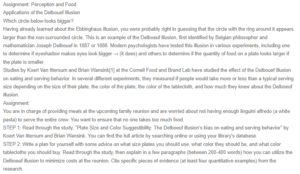Perception and Food – The Delboeuf Illusion
Utilizing the Delboeuf illusion to minimize costs at the upcoming family reunion when serving linguini alfredo is a smart approach to ensure that no one takes more food than necessary, based on the findings of the study by Koert Van Ittersum and Brian Wansink. The study “Plate Size and Color Suggestibility: The Delboeuf Illusion’s bias on eating and serving behavior” provides valuable insights that can be applied to meal planning. This paper presents a plan with specific advice on plate size, color, and tablecloth selection, backed by evidence from the research.
Plate Size
The research suggests that plate size significantly impacts serving and eating behavior. I will opt for smaller plates to ensure guests take only a little linguini alfredo. Smaller plates create an illusion of larger food portions, leading people to serve themselves less. For instance, the study demonstrated that individuals served themselves 22% less food when using smaller plates than larger ones (Van Ittersum & Wansink, 2012). Thus, it is advisable to choose smaller plates, such as 9 inches, to help control portion sizes effectively.
Plate Color
The color of the plates can also play a role in portion control. The study shows that contrasting plate and food colors can help people gauge their serving sizes better. For serving linguini alfredo, I will select plates contrasting the pasta, such as dark-colored plates. In one of the experiments, participants who used plates with a contrasting color to their food served 10% less than those with similar colored plates (Van Ittersum & Wansink, 2012). This can help reduce the amount of linguini alfredo consumed by the guests.
Tablecloth Color
The color of the tablecloth can influence the perception of portion sizes. I will choose a tablecloth color that contrasts with the color of the plates and the linguini alfredo to create a visual boundary that aids in portion control. The study’s findings support the idea that tablecloth color matters; those using a contrasting tablecloth served 9% less food than those with a matching tablecloth (Van Ittersum & Wansink, 2012).
Knowledge about the Delboeuf Illusion
Finally, it is important to have knowledge about the Delboeuf illusion. Hence, educating people about how plate size, color, and tablecloth color can influence their perception of portion sizes can help them make more mindful choices when serving themselves, reducing food costs and wastage.
References
Van Ittersum, K., & Wansink, B. (2012). Plate Size and Color Suggestibility: The Delboeuf illusion’s bias on eating and serving behavior. Journal of Consumer Research, 39(2), 215-228. https://doi.org/10.1086/662615.
ORDER A PLAGIARISM-FREE PAPER HERE
We’ll write everything from scratch
Question 

Perception and Food – The Delboeuf Illusion
Assignment: Perception and Food
Applications of the Delbouef Illusion
Which circle below looks bigger?
Having already learned about the Ebbinghaus illusion, you were probably right in guessing that the circle with the ring around it appears larger than the non-surrounded circle. This is an example of the Delboeuf illusion, first identified by Belgian philosopher and mathematician Joseph Delbouef in 1887 or 1888. Modern psychologists have tested this illusion in various experiments, including one to determine if eyeshadow makes eyes look bigger → (it does) and others to determine if the quantity of food on a plate looks larger if the plate is smaller.
Studies by Koert Van Ittersum and Brian Wansink[1] at the Cornell Food and Brand Lab have studied the effect of the Delbouef illusion on eating and serving behavior. In several different experiments, they measured if people would take more or less than a typical serving size depending on the size of their plate, the color of the plate, the color of the tablecloth, and how much they knew about the Delboeuf illusion.
Assignment:
You are in charge of providing meals at the upcoming family reunion and are worried about not having enough linguini alfredo (a white pasta) to serve the entire crew. You want to ensure that no one takes too much food.
STEP 1: Read through the study, “Plate Size and Color Suggestibility: The Delboeuf illusion’s bias on eating and serving behavior” by Koert Van Ittersum and Brian Wansink. You can find the full article by searching online or using your library’s database.
STEP 2: Write a plan for yourself with some advice on what size plates you should use, what color they should be, and what color tablecloths you should buy. Read through the study, then explain in a few paragraphs (between 200-400 words) how you can utilize the Delboeuf illusion to minimize costs at the reunion. Cite specific pieces of evidence (at least four quantitative examples) from the research.